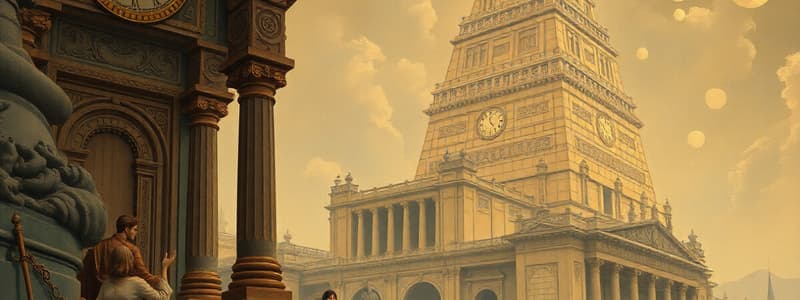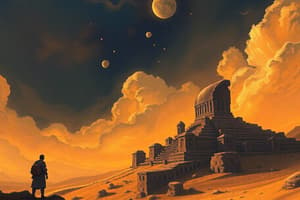Podcast
Questions and Answers
How does Shelley use the sonnet form in 'Ozymandias' to convey his message about power?
How does Shelley use the sonnet form in 'Ozymandias' to convey his message about power?
- He uses the sonnet form to highlight Ozymandias's love for himself. (correct)
- He uses an irregular rhyme scheme within the sonnet to suggest that established power structures can be challenged and changed. (correct)
- He adheres strictly to the traditional sonnet structure to emphasize the enduring nature of Ozymandias's legacy.
- He avoids the sonnet form altogether to create a sense of chaos and impermanence.
What is the significance of the phrase 'shattered visage lies' in the context of the poem?
What is the significance of the phrase 'shattered visage lies' in the context of the poem?
- It emphasizes the enduring beauty and artistic skill of the sculptor.
- It highlights the powerful and lasting impact of Ozymandius's military conquests.
- It serves as irony, contrasting Ozymandius's intended image of strength with the reality of his ruined statue and civilization. (correct)
- It shows the importance of preserving historical artifacts.
How does the poem explore the theme of human power and corruption?
How does the poem explore the theme of human power and corruption?
- By portraying Ozymandius as a benevolent ruler who brought prosperity to his people.
- By depicting Ozymandius's arrogance and tyranny, suggesting that absolute power corrupts. (correct)
- By illustrating the lasting legacy of Ozymandius's achievements and contributions to society.
- By focusing on the beauty and grandeur of Ozymandius's palace and kingdom.
In what ways does Shelley use the character of Ozymandius to represent King George III?
In what ways does Shelley use the character of Ozymandius to represent King George III?
How does the line 'Look on my works, Ye Mighty, and despair!' contribute to the central message of the poem?
How does the line 'Look on my works, Ye Mighty, and despair!' contribute to the central message of the poem?
What is the significance of Shelley's choice to present the narrative through a 'traveller' in 'Ozymandias'?
What is the significance of Shelley's choice to present the narrative through a 'traveller' in 'Ozymandias'?
How does the poem 'Ozymandias' highlight the power of nature?
How does the poem 'Ozymandias' highlight the power of nature?
What does the 'sneer of cold command' suggest about Ozymandius's leadership style?
What does the 'sneer of cold command' suggest about Ozymandius's leadership style?
How does the use of alliteration in 'boundless and bare' enhance the poem's meaning?
How does the use of alliteration in 'boundless and bare' enhance the poem's meaning?
What is the effect of Ozymandius declaring 'My name is Ozymandius, King of Kings'?
What is the effect of Ozymandius declaring 'My name is Ozymandius, King of Kings'?
Which of the following themes is NOT a central focus of Percy Shelley's 'Ozymandias'?
Which of the following themes is NOT a central focus of Percy Shelley's 'Ozymandias'?
How does the positioning of 'Nothing besides remains' within the poem affect its interpretation?
How does the positioning of 'Nothing besides remains' within the poem affect its interpretation?
How might the phrase 'Its sculptor well those passions read' shape our understanding of Ozymandius?
How might the phrase 'Its sculptor well those passions read' shape our understanding of Ozymandius?
In 'Ozymandias,' how does Shelley use irony to undermine the perceived power of the titular ruler?
In 'Ozymandias,' how does Shelley use irony to undermine the perceived power of the titular ruler?
How does Shelley's use of a fragmented statue contribute to the themes explored in 'Ozymandias'?
How does Shelley's use of a fragmented statue contribute to the themes explored in 'Ozymandias'?
What is the relationship between human pride and the 'forces of time and nature'?
What is the relationship between human pride and the 'forces of time and nature'?
What is the allegorical significance of 'Ozymandias'?
What is the allegorical significance of 'Ozymandias'?
How does Shelley's choice of language, such as 'colossal wreck,' contribute to the overall tone?
How does Shelley's choice of language, such as 'colossal wreck,' contribute to the overall tone?
How does the poem's desert setting contribute to its themes?
How does the poem's desert setting contribute to its themes?
How does the poem explore themes of oppression and inequality?
How does the poem explore themes of oppression and inequality?
Flashcards
Sonnet Form in Ozymandias
Sonnet Form in Ozymandias
A traditional poetic form, often used for love poems; here employed by Shelley to critique Ozymandias' self-love.
Detached Narrator
Detached Narrator
The poem uses a narrator who relays a story from a traveler, distancing Shelley from potential repercussions of criticizing authority.
Allegory in Ozymandias
Allegory in Ozymandias
Ozymandias symbolizes King George III, allowing Shelley to critique the monarchy indirectly.
Irony of 'Shattered Visage'
Irony of 'Shattered Visage'
Signup and view all the flashcards
Sneer of Cold Command
Sneer of Cold Command
Signup and view all the flashcards
King of Kings
King of Kings
Signup and view all the flashcards
Irony in 'Look on my Works'
Irony in 'Look on my Works'
Signup and view all the flashcards
Nothing Besides Remains
Nothing Besides Remains
Signup and view all the flashcards
Boundless and Bare
Boundless and Bare
Signup and view all the flashcards
Sculptor's Perception
Sculptor's Perception
Signup and view all the flashcards
Conflict
Conflict
Signup and view all the flashcards
Fleeing power
Fleeing power
Signup and view all the flashcards
Study Notes
- The poem "Ozymandius" explores themes of human power and corruption, the power of nature, oppression and inequality, and memory and loss.
Background
- The poem is a sonnet, traditionally used for love poems, but Shelley uses it to show Ozymandias’ self-love.
- The irregular rhyme scheme demonstrates that established power structures can be changed.
- Ozymandius is another name for Ramses II, a powerful Egyptian pharaoh known for his military conquests.
- Key themes include the fleeting nature of human power and the conflict between human pride and time and nature.
Quotes
- "A traveller … who said"
- The poem begins in first person but quickly shifts to another's voice, creating a detached narrator.
- The detached narrator distances Shelley from repercussions and allows him to critique the monarchy from an anti-establishment viewpoint.
- This poem is an allegory where Ozymandius represents King George III.
- “Shattered visage lies”
- This phrase shows irony, as Ozymandius' power was rooted in his image of strength, the fragmented statue symbolizes a broken civilization reduced to sand.
- “Sneer of cold command”
- Underlines Shelley’s pacifism, alluding to King George's disregard for soldiers.
- Cruel features remain even after the statue's decay, underlining the monarchy’s cruelty.
- “My name is Ozymandius King of Kings”
- Shelley uses the biblical phrase “King of Kings” to emphasise Ozymandius’ ego, who thinks of himself as greater than God.
- The line has eleven syllables, while the others have ten because Ozymandius sees himself as more important than time.
- “Look on my works, Ye Mighty and despair”
- The irony lies in the statue's ruined state, with Shelley suggesting that time and nature outlast human power.
- The poem explores how time breaks down human works, especially power based on fear.
- “Nothing besides remains”
- The shortest sentence represents the finality of death.
- “Boundless and bare”
- In the desert setting, Shelley portrays nature’s infinite power.
- Alliteration emphasises is used here, acting as a metaphor for the passing of time.
- A powerful king’s words now have no meaning.
- “Its sculptor well those passions read”
- His people perceived him clearly.
Studying That Suits You
Use AI to generate personalized quizzes and flashcards to suit your learning preferences.




